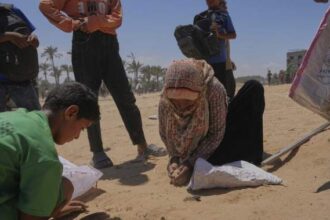The tranquility of a summer weekend in West Virginia’s rural communities was shattered when torrential rains triggered devastating flash floods, leaving a trail of destruction that has claimed at least four lives and prompted desperate search efforts for those still missing.
“It came without warning,” said Marion County Sheriff James Riffle, describing the wall of water that swept through several communities early Sunday morning. “People were asleep in their beds when creeks and streams rose nearly eight feet in less than an hour.”
Emergency responders report that the hardest-hit areas include Marion, Monongalia, and Preston counties, where several small towns were effectively cut off as floodwaters washed away bridges and rendered roads impassable. The National Weather Service confirmed that over 7 inches of rain fell in a six-hour period, overwhelming local waterways and drainage systems.
Among the confirmed dead are an elderly couple who became trapped in their vehicle while attempting to evacuate, and two residents whose homes collapsed under the pressure of the raging waters. Their identities are being withheld pending notification of next of kin.
Governor Catherine Reynolds has declared a state of emergency for seven counties and deployed National Guard units to assist with rescue operations. “We’re bringing every resource to bear in the search for survivors,” Reynolds said during a press conference at the state’s Emergency Operations Center. “Our priority now is saving lives and providing immediate relief to displaced families.”
The West Virginia Department of Transportation estimates that at least 12 bridges have been destroyed and more than 30 miles of roadway have suffered significant damage, complicating rescue efforts. Helicopter teams have been airlifting stranded residents from rooftops and isolated areas.
At a makeshift shelter in the Fairmont High School gymnasium, dozens of displaced residents await news of missing family members. Marjorie Tanner, who was separated from her husband during their escape from their flooding home, sat clutching her phone. “The water came so fast we barely had time to get out. Last I saw, Tom was trying to save our photo albums. That was hours ago.”
Climate scientists from West Virginia University have noted that this event follows a concerning pattern of increasingly severe weather events in the Appalachian region. Dr. Helena Morris, professor of atmospheric science, told CO24 News: “What we’re witnessing aligns with projections of how climate change affects precipitation patterns in this region. These once-rare extreme rainfall events are becoming more frequent and more intense.”
The economic impact will likely be severe for a region already struggling with persistent poverty. Early estimates from the state’s emergency management agency suggest damages could exceed $200 million, with hundreds of homes destroyed or rendered uninhabitable.
Federal assistance has been mobilized, with FEMA teams deploying to establish disaster recovery centers. “We’re bringing in temporary housing units, emergency supplies, and financial assistance personnel,” said FEMA Regional Administrator Thomas Bennett. “But the geography of this region makes this a particularly challenging response operation.”
As rescue efforts continue through the night, illuminated by emergency floodlights and the beams of search helicopters, communities across West Virginia are rallying to support their neighbors. Local churches and businesses have established donation centers, while volunteer rescue teams from neighboring states have arrived to bolster search efforts.
With more rain in the forecast, officials worry about the potential for additional flooding. “The ground is saturated, and many waterways remain well above flood stage,” warned National Weather Service meteorologist Sandra Patel. “Even moderate rainfall could trigger additional flash flooding in the coming days.”
As this disaster continues to unfold, one question looms large for West Virginia’s vulnerable mountain communities: In a changing climate with increasingly extreme weather events, how can these historic towns, many built in narrow valleys along waterways, adapt to survive the floods that seem destined to become more frequent and more devastating?










